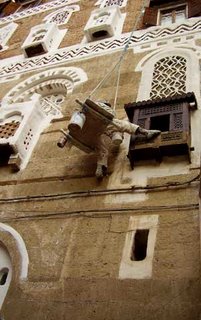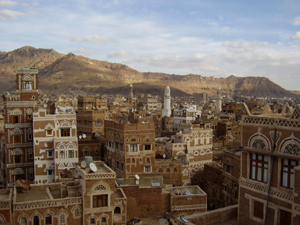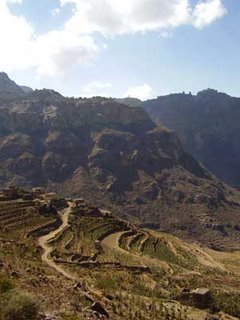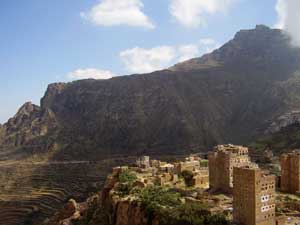







To see an excerpt from the book, please click on the link below ! http://www.scribd.com/share/upload/9090128/aehe2fnj1ikpsedbqgg
Most people don't associate Jews with North-Africa or the Islam. However, until the second half of the twentieth century, Jewish communities lived about everywhere (about 700.000 - 800.000) around the Mediterrean, in Northern Africa, the Middle East, the Arabic penisula and Asia (Egypt, Iraq, Turkey, Yemen,..). Today there are almost no Jews left. How did they end up there and why did they leave?
The book brings this historial chapter of North-Africa back to life. It contains archive material, postcards, and pieces of art from private collections and museums in Morocco, Belgium, France and Israel. They demonstrate to what extent Jewish influences are still present in the Moroccan way of life, the culture, the economy, the craftmanship and even the typical Moroccan traditions and customs. The colourful illustrations (87 in total) show jewelery, clothing and decorative art (silver- and golsmith , silk embroidery, Berber tapestry, copper- and woodwork ).
Long before the arrival of Islam, Jewish communities lived together with the indigenous population of North-Africa, the Berbers. Jewish Berber tribes resisted the Arab conquest of North-Africa during several decades. The Jewish influences in the Berber culture are recognisable until the present day. The Jews and Berbers had many things in common: the Berber language, customs such as the veneration of Jewish saints,...Until the second half of the second century, almost every Moroccan town had a small Jewish population. Jews and Berbers shared the same neighbourhoods, the same musical customs and poetry.
After the Arab conquest, the Moroccan Jews integrated very fast into Muslim society and adopted a special status. Under the Islamic law, the Jews were recognised as a religious minority, dhimmi, and they had the right to exercise their religion - however in exchange for a poll tax. They also had to display a humble attititude towards their Muslim neighbours and, during certain periods, they even had to wear distinctive clothing, to distinguish themselves from the Muslims.
From the beginning of Muslim reign, the Jews played an important role in Muslim society because of heir commercial contacts throughout the Mediterranean and their multilingualism.
The Muslim conquest of Spain was the beginning of a whole new chapter in the history of Moroccan Jewry.
Numerous (Berber)Jews participated in the conquest of Spain and contributed to the 'civilisation' of Al-Andalus. These Jews, named Sephardic Jews - because of the Hebrew name for Spain - Sefarad played a significant role in science, economy and culture (Arabo-Andalusian music) of Muslim Spain. Jewish thinkers were also influentual in music, poetry and philosophy. The Jewish philosopher Moses Maimonides or "Rambam" laid the foundations for a ynthesis between the Greek, Jewish and Christian philosophy. In addition to reading the works of Muslim scholars, he also read those of the Greek philosophers made accessible through Arabian translators. Thus, he became one of the medieval Jewish philosophers who also influenced the non-Jewish world, long before the ideas of the Renaissance took root in Europe. Today, Maimonides works and his views are considered a cornerstone of Jewish thought and study.
During the fifteenth and sixteenth centuries, this Spanish-Jewish heritage was spread all over the world, and particularly in Morocco, where the Jews and Muslims who expelled from Spain by the catholic kings took refuge. These Spanish Jews, also called "megorashim", became the most influentual Jewish population in Moroccan cities such as Fez, Tetouan and Salé. They lived side by side with the "native" Moroccan Jews, the so-called "toshavim" and they continued to foster their specific cultural traditions.
In Spain, the Jews could for the first time achieve high positions in Muslim society (contrary to their coreligionnaries in Morocco). From the tenth century on, some so-called "Court Jews" served as interpreters, bankers, investors, counselors and even as vizir (the second highest rank in the Muslim court).
In Morocco however, the Jews played a role as intermediaries between the Arab speaking population and the Berbers and they often worked as traveling salesman. But because of their minority status, they were often subject to the arbitrary treatment by local governors. Their dhimmi-status did not offer them protection against the humiliations, looting and even murders, to which they were regularly subjected by the Muslims. Nevertheless, the rulers clearly recognised the strategic importance of the Jews, in particular of those located along the Trans-Saharan trade routes. The Moroccan Jews had a long tradition in this trade. Salt, sugar, gold, copper and ivory were brought by caravanes from south of the Sahara through the desert by camels and then along the Morocan trade routes that ran through the country, from the Atlas mountains to Fez and to the cities in the north.
The Jews had a large network of contacts with their coreligionists south of the Sahara, in Algeria, along the Mediterrean coasts and throughout the Middle East . For many centuries, and in particular during the fourteenth century, the Jewish traders were working together with the Moroccan rulers, who wanted to control this lucrative trade. Sugar, salt, goldFez became the centre of this flourishing trade. The famous trade district "Kissaria" was according to the testimonies of travelers only comparable to the Souq of Cairo.
The worst period for the Moroccan Jews was during the reign of the Almohads. The sultans of this dynasty didn't recognise the dhimmi -status and murdered thousands of Jews. Many of them were forced to convert to Islam. This explains Moroccan names such as Cohen and Kessos/Jesus. It was only under the Merinid sultans (1240-1465) that the Jews had the right to profess their religion openly again. Because of the lootings and the general hostility however, the Merinid sultans built a special quarter, next to the royal palace, surrounded by high walls. This sheltered quarter, which was for the first time erected in Fez, received the name "Mellah", (the Arabic word for "salt"), because the area had previously served as a salt depot. Gradually, more and more Moroccan cities founded their own Jewish quarters or "Mellahs", which were however not comparable to the European ghetto's. The Jewish community enjoyed a big autonomy, and in times of political and economical prosperity, the relations between Muslim and Jewish merchans were friendly, although the Jews always stayed second class citizens in the eyes of the Muslims.
Starting from the fifteenth century, the Moroccan sultans realized the advantage the Jews presented for their commercial contacts with Europeans. Due to their many contacts and their vulnerable status in Moroccan society, the Jews were suited for variious positions as intermediaries and translators. They often served as a instrument of the power of the Sultan. Many Jews - often wealthy merchant families who had come from Andalucia - received the title of "Merchant of the Sultan", which entitled them to do business in the name of the Sultan.
European protection
During the nineteenth century, the European powers extended their influence to North-Africa, thanks to the technological advancement in the shipbuilding and in firearms. Morocco was very interested in the arm trade, while European traders bought Moroccan farm products, such as olive oil, wool and corn. Many Europeans settled in Morocco and employed Jewish agents. Many Moroccan Jews also started working for the European consulates and embassies, which were sprouting up in all the important Moroccan cities . They worked as clerks, translators and even ambassadors. These so-called protégés often took on the nationality of the foreign power they were working for, to be exempted from thev Moroccan tax system and the Muslim justice system.
Due to the rural exodus during the nineteenth century, many Moroccan cities became overcrowded. The gap between the prosperous Jews, who often lived outside the Medina in the European quarters, and the poor (often "native" or "Berber Jews") widened. In the Jewish quarters or "Mellahs" poverty struck and the sanitary conditions were poor, causing epidemies.
In 1862, the philantrophic French-Jewish organisation "Alliance Israélite Universelle" opened her first school in Tetouan. The objective of this organisation was to improve the situation of the Jews mainly in the Muslim world, by means of education. In the beginning, its activities in Morocco concentrated on improving the sanitary conditions and the health of the Jewish children. At the turn of the century and starting from the French Protectorate (1912), the "Alliance Israélite Universelle" expanded her activities throughout Morocco, even in the most remote villages in the Atlas mountains. The Jewish children were socialised according to the French "civilization" and values. This lead to an emancipation of the Moroccan Jews, but the same time to a loss. The Jewish-Moroccan heritage was not valued by the French governors, and thus the young generation of Moroccan Jews lost the contact with their roots.
On the other hand, the Protectorate offered many the opportunity to gain access to important functions in the administration and the economic life, thanks to their excellent knowlegde of the French language and their familiarity with the French culture. In Tanger, the first newspapers, banks and credit institutions were founded by graduates of the "Alliance" schools. A visible sign of the social ascension of this generation was their adoption of European (French) names, habits, clothing and general lifestyle. Moreover, under the French rule, the Moroccan Jews received fully legal status under the French law (even if they did not receive the French nationality), which meant that they were exempted from the dhimmi-status and they were no longer subject to the Sharia.
Nevertheless, the French Protectorate did not bring about fundamental changes of the legal status of the Jews, because the French governors had promised they would not interfere in the religious institutions and structure of Moroccan society. During the Second Word War, the Moroccan Jews were subjected to the discriminatory laws of the French Vichy regime. Thanks to the energetic protest of the Moroccan King Mohamed V, in an attempt to protect his Jewish subjects, Moroccan Jews were saved from deportation. Nevertheless, they lost their jobs and positions as lawyers and accountants in the French administration, positions they had only recently acquired through their hard struggle for emancipation.
The emigration to the promised land: the "Alia"
Whilst zionist ideas had rarely taken root in Morocco (apart from some exceptions) during the French Protectorate, in the wake of the Second World War they started to have an impact on the Moroccan Jews.
International events such as the foundation of Israel, Moroccan independence and the conflict between Israel and its Arab neighbours, placed the Moroccan Jews for a dilemma of loyalties and gave rise to anti-Jewish sentiments in the Moroccan society. After the foundation of Israel, many of them decided to leave and to build up a new future in the promised land. In 1964, 100.000 of the approximately 250.000 Jews had already left Morocco, to emigrate to Israel, Algeria and France. Between the end of the 1960 and the end of the 1990's, another 150.000 Jews emigrated to Canada, Europe and the Americas. Today, an estimated number of 5000 Jews is still living in Morocco. Morocco is thus the only Arab country with a Jewish community. Most of them live in Casablanca, but there are also small Jewish communities in Rabat, Tanger and Marrakech. They have their own schools, hospitals and retirement homes. Some Jews are still occupying important positions in the Moroccan economy and government, such as André Azoulay, who is advisor to the Moroccan king Mohamed VI.
Jewish-Moroccan singers, such as Samy el-Maghrebi, enjoy a big popularity among Jews and Muslims, in Morocco and Israel. The Moroccan Jews who emigrated can keep their Moroccan nationality for life. Many thousands of them return each year to Morocco, to celebrate Jewish fests, take part in pilgrimages to the graves of Jewish saints and to visit their relatives. Rarely any other Jewish community in the world fosters such close ties with the land of its ancestors as the Jews from Morocco.
The Moroccan Jews have contributed to a large extent to the Moroccan economy and culture, the fine arts and music, and not to forget, the Moroccan cuisine. This important contribution and cultural heritage has recently received much recognition in Moroccan media and society.








